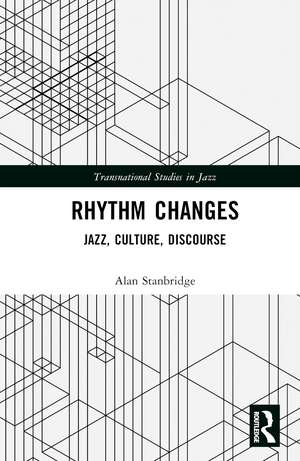Rhythm Changes: Jazz, Culture, Discourse: Transnational Studies in Jazz
Autor Alan Stanbridgeen Limba Engleză Hardback – 30 mar 2023
| Toate formatele și edițiile | Preț | Express |
|---|---|---|
| Paperback (1) | 312.00 lei 22-36 zile | +24.78 lei 5-11 zile |
| Taylor & Francis – 29 noi 2024 | 312.00 lei 22-36 zile | +24.78 lei 5-11 zile |
| Hardback (1) | 959.87 lei 43-57 zile | |
| Taylor & Francis – 30 mar 2023 | 959.87 lei 43-57 zile |
Din seria Transnational Studies in Jazz
-
 Preț: 287.27 lei
Preț: 287.27 lei -
 Preț: 288.80 lei
Preț: 288.80 lei -
 Preț: 302.02 lei
Preț: 302.02 lei -
 Preț: 295.84 lei
Preț: 295.84 lei -
 Preț: 286.42 lei
Preț: 286.42 lei -
 Preț: 312.00 lei
Preț: 312.00 lei -
 Preț: 412.37 lei
Preț: 412.37 lei -
 Preț: 433.26 lei
Preț: 433.26 lei -
 Preț: 452.31 lei
Preț: 452.31 lei -
 Preț: 409.51 lei
Preț: 409.51 lei -
 Preț: 412.45 lei
Preț: 412.45 lei -
 Preț: 381.21 lei
Preț: 381.21 lei -
 Preț: 409.48 lei
Preț: 409.48 lei - 26%
 Preț: 765.40 lei
Preț: 765.40 lei -
 Preț: 382.90 lei
Preț: 382.90 lei -
 Preț: 302.75 lei
Preț: 302.75 lei -
 Preț: 383.50 lei
Preț: 383.50 lei -
 Preț: 383.71 lei
Preț: 383.71 lei -
 Preț: 383.12 lei
Preț: 383.12 lei -
 Preț: 382.57 lei
Preț: 382.57 lei
Preț: 959.87 lei
Preț vechi: 1170.57 lei
-18% Nou
183.67€ • 192.25$ • 152.87£
Carte tipărită la comandă
Livrare economică 31 martie-14 aprilie
Specificații
ISBN-10: 1032251891
Pagini: 378
Ilustrații: 28 Halftones, black and white; 28 Illustrations, black and white
Dimensiuni: 152 x 229 x 22 mm
Greutate: 0.86 kg
Ediția:1
Editura: Taylor & Francis
Colecția Routledge
Seria Transnational Studies in Jazz
Locul publicării:Oxford, United Kingdom
Public țintă
AcademicCuprins
1. The Challenge of the Past: Jazz, Parody, and Jazz Discourse
They Brainwash and Teach You Hate: From Parody to Protest2. A Few of My Favorite Things: Analyzing Jazz, Interpreting Irony, Assessing Value
It Ain’t Necessarily So: From Caricature to Celebration
In a Sentimental Mood: From Ridicule to Romanticism
Notes
"Saying Something": Coltrane, Irony, and ‘My Favorite Things’3. My Only Sunshine: Jazz, Country Music, George Russell, and Musical Meaning
"White Things," Black Things, and a Few Other Things
"Undeniable Qualities": Homage, Value-For, and Ideological Hegemony
"Myriad Subtleties," Bebop Parody, and the Question of Context
"We’re in the Money": Irony, Complexity, and Social Normativity
Notes
Way Out West: From Cowhand Sonny to Dangerous Davey4. Divine Revelations: Keith Jarrett, Acoustic Authenticity, and Romantic Genius
Cowboy Favorites: Jazz Meets Country Music
You Are My Sunshine: From Singing Cowboys to Gassed Soulsters
Happy Endings: George Russell Meets ‘You Are My Sunshine’
Sunshine Redux: From Kiddies Songs to Kitchen Appliances
Notes
Fun With Toys: Miles, Electricity, and Acoustic Relief5. The Body Electric: Music, Machines, and Mechanical Reproduction
A Blazing Forth of a Divine Will: Blank Slates, Claptrap, and Emphysemic Goats
Body and Soul: Sacred Space, the State of Grace, and Everyday Ecstasy
Blessed With Genius: The Flame Itself, the Man from Porlock, and the Heavenly Ostrich
Play On, Play On: Robert Bly, the Wild Man, and the Neglected Male Psyche
Touch the Soil: Elemental Instruments, Indian Country, and the Noble Savage
Notes
I Sing the Body Electric: Aesthetic Materialism, Technological Humanism, and Electrical Grandmothers
Spark of Being: Frankenstein, Electricity, and the Merging of Text and Form
Undervaluing Overdubbing: Jazz, Spontaneity, and Recording Studio Trickery6. Can Blue Men Sing the Whites? African American Exceptionalism, European Stereotypes, and the Jazz Studies Debate
Essential and Divine: Faithful Fidelity, Analogue Authenticity, and "exactly what was played"
Preserving Spontaneity: Free Improvisation, Live Performance, and the Paradox of Sound Recording
Notes
Getting To Know You: The ‘Afrological,’ the ‘Eurological,’ and the IllogicalReferences
The Anxiety of Affluence: Race, Class, and European ‘Privilege’
A Pan-European Conspiracy? Cultural Nationalism, Nativist Politics, and Foreign Competitors
The Emancipation Problem: African American Models and German Belligerents
A Delicate, Nuanced Approach? Humour, Improvisation, and Composer-Centred Music
Networks of Power: Whiteness, Erasure, and World Harmony
Postscript: Say It Loud, I’m British and I’m Proud
Notes
Discography
Filmography
Notă biografică
Descriere
Rhythm Changes: Jazz, Culture, Discourse explores the history and development of jazz, addressing the music, its makers, and its social and cultural contexts, as well as the various discourses – especially those of academic analysis and journalistic criticism – that have influenced its creation, interpretation, and reception.
Tackling diverse issues, such as race, class, nationalism, authenticity, irony, parody, gender, art, commercialism, technology, and sound recording, the book’s perspective on artistic and cultural practices suggests new ways of thinking about jazz history. It challenges many established scholarly approaches in jazz research, providing a much-needed intervention in the current academic orthodoxies of Jazz Studies.
Perhaps the most striking and distinctive aspect of the book is the extraordinary eclecticism of the wide-ranging but carefully chosen case studies and examples referenced throughout the text, from nineteenth century literature, through 1930s Broadway and film, to twentieth and twenty-first century jazz and popular music.
